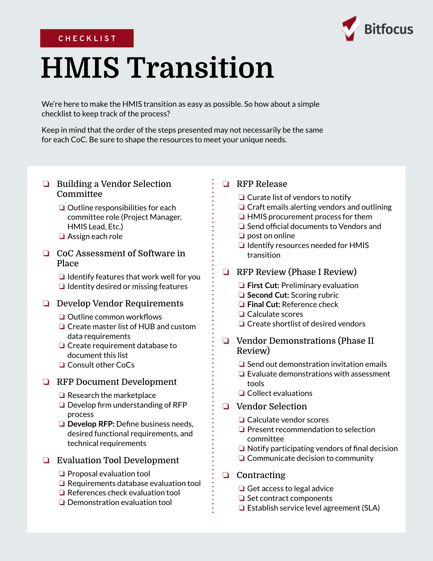


So, your continuum of care (CoC) thinks it might be time to replace its HMIS. The existing system just doesn’t cut it, and you notice that other continuums are using an HMIS that has more features, is easier to use, and comes with better customer service.
Your community is simply ready to move on and find a better solution.
Of course, that’s easier said than done. The HMIS transition process can be frustrating, difficult, and time-consuming. It requires carefully managing a constellation of policy considerations, stakeholders, technical knowledge, governmental oversight, community expectations, time constraints, and financial pressures. All of these must be brought into balance, so even the most seasoned project managers might shiver at the thought of embarking on such an adventure.
And an adventure it is! Like any journey, it helps to have a guide, map, and compass. Bitfocus has successfully led many clients through the murky waters of an HMIS transition, and we want to share what we’ve learned with you.
That’s why we’ve created the Bitfocus HMIS Transition Guide.
This comprehensive document is designed to help you plan, organize, manage, and assess all the steps as you move toward finding a new HMIS vendor and transitioning to a new system.
Covers the process of RFP creation, proposal and demo assessments, vendor selection, and contracting
Goes over implementation and data migration, training, system administration, and security reviews
Covers establishment of the system administration practices, training, and security policies
Guides the development and formation of HMIS governance committees

We’re here to make the HMIS transition as easy as possible. So how about a simple checklist to keep track of the process? Keep in mind that the order of the steps presented may not necessarily be the same for each CoC. Be sure to shape the resources to meet your unique needs.
We’ve curated the content of this toolkit to ease the hassle and headache of the transition to a new HMIS. Although it’s a challenging process, it also might actually be fun! And Bitfocus believes that doing a good job should be fun.
We hope we can help you streamline your transition effort in an enjoyable way, strengthen community ties, and expand your knowledge so you can get back to doing what you do best: serving the homeless.
The RFP and Vendor Selection Toolkit will assist you from the very beginning stages of RFP development all the way to contracting with your new vendor. The tools we've included cover everything from surveys that can assess your current HMIS to sample RFPs and vendor evaluation questionnaires. We've created some of the tools and resources; others come from different sources, and we have referenced them as weblinks so that you can access them online.
Two important things to note:
The order of the documents presented may not necessarily be a good fit for your CoC. Every CoC is different, so be sure to shape these resources to meet your unique needs.
Establish a plan early on. You can always change it, but having identifiable goals, stages, milestones, and deliverables will help you organize your steps and delegate tasks.
Go forward with confidence.

S T A G E 1
Objective: Create a vendor selection committee to oversee the procurement process
The vendor selection process is drawn-out, arduous, time-consuming and requires patience, stamina, and perseverance. However, if executed correctly, it yields fantastic outcomes.
So, what's the key to getting positive results and staying on a smooth-sailing path?
A team of good people.
The team that participates in the procurement process should include a multidisciplinary group of people who approach the problem from different angles. This diversity in viewpoints will ensure that you’ll reach a robust and intelligent decision based purely on community needs and stakeholder interests.
|
ROLE |
RESPONSIBILITY |
| IT Professionals |
IT professionals will hone in on all technological things so your team selects a technically sound product. |
|
Project Manager |
The project manager will lead the effort and organize activities to keep everyone on the same page and meet appropriate milestones. |
|
System Administrators / HMIS Leads |
System administrators/HMIS Leads will identify the shortfalls of the current system and envision how to avoid them in the future, as well apply their understanding of the HUD regulations to ensure that the new database meets all the requirements. |
|
Data Analysts & Agency Managers |
Data analysts & agency managers will have excellent insight into the reporting needs and analytics that the community will need to satisfy current and future reporting capability. |
|
HUD Technical Assistance Providers |
HUD technical assistance providers are good folks to have on the committee because they have exposure to other communities and insight into future HUD requirements, which will prove to be an asset during this process. |
|
CoC Representatives |
Having CoC representation is very instrumental in understanding the needs of the CoC, and they will be looking at the situation from a 50-foot view (larger paradigm). |
|
End-Users |
Getting feedback and input from end-users is important in selecting a product that optimizes user experience and has a logical workflow. |
The most important members of the committee will be, arguably, the end-users themselves. They interact with the database on a daily basis and can share ideas on how to make it more efficient. They also provide excellent insight into current shortfalls. Soliciting their input will help you select a product that optimizes user experience and has a logical workflow.
Why is this important?
If the end-users can’t enter quality data, nothing else is achievable. The analyst won’t have reliable data to analyze, the CoC can’t make data-driven quality decisions, and the community won’t be able to gauge its progress in ending homelessness.
Now that you have a fantastic team of people at the table, it’s time to assess the current software and plan for the future.
This is a chart for tracking all the known expenses related to finding, purchasing, and implementing a new HMIS. Use it to budget your funds and track expenses for each stage in the HMIS procurement process.
Stakeholder Influence Analysis Chart ↗
By organizing a list of key HMIS stakeholders in your community and identifying their level of influence, you can track them and design your stakeholder engagement strategy.
What Is Stakeholder Analysis and Mapping and How Do You Do It Effectively? ↗
This article describes the process of stakeholder analysis and mapping. It also provides advice on identifying which portions of a project are related to each stakeholder. Use this for ideas on how to coordinate stakeholder activity and provide support for the community to ensure the project's success.
Cross-cutting Tool: Stakeholder Analysis ↗ This guide defines what stakeholder analysis is, explains why it's important, and how to do it. Use this to learn the basics of stakeholder analysis and plan your community engagement strategy.
Vendor Selection Committee Roles & Responsibilities ↗
This a list of the key roles and responsibilities of the team members on your HMIS vendor selection committee. Use it to assign roles, determine who should be involved in the planning sessions, and track general responsibilities.
Communication Management Matrix ↗ A tool for planning and tracking communications, the communication management matrix will help you coordinate the communication activity of all teammates working on the project.
Standard Project Roles & Responsibilities ↗ Describes the typical roles and responsibilities for projects and programs. Use this to assign roles to your staff members and define their duties.
Stakeholder Register Template ↗
A stakeholder registration template. Use this for cataloging stakeholder information, planning communication, and assessing stakeholder influence.
Stakeholder Communication Plan Template ↗
Use this tool to strategize the communication activity between your team and the stakeholders.
Creating a Stakeholder Communications Plan ↗
This guide defines what a stakeholder communication plan is and explains why you need one and how to develop it.
How to Create a Stakeholder Management & Communication Plan ↗
Learn the steps on how to make both a stakeholder management plan and a stakeholder communications plan. This article also explains how to merge the plans into one multi-purpose document. Use this information to coordinate all your actions involving stakeholder engagement.

S T A G E 2
After assembling your Vendor Selection Committee, the next step is to assess your current software. This will help you identify the features that work, detect the ones that don’t, and pinpoint those that are missing. All of these efforts will help you identify your system requirements, which in turn you will use to develop the content of your RFP.
HMIS Self-Assessment Survey (Example) ↗
This comprehensive guide includes recommendations for writing, scoring, and conducting a survey in your organization to evaluate your HMIS. It also features an extensive list of sample HMIS-related survey questions and a basic scoring rubric. Use this guide to get feedback from your team about your current HMIS and to catalog features that you want in a new system and services you require from a vendor.
The SWOT is a strategic analysis tool that helps identify strengths, weaknesses, opportunities, and threats. Use this tool to help you evaluate the current software in place.
Software Selection Tips Blog ↗
This resource, a collection of tips about selecting software, expounds upon the phases involved in searching for and choosing software. Consult this for advice when searching for an HMIS.
Standard RFP Process Flowchart ↗
This flowchart covers the principal phases of the RFP process to guide your RFP development.

S T A G E 3
Now that you have reviewed your current HMIS and identified its strengths and weaknesses, you’re ready to start developing a list of features and functionality that you want in your new HMIS. The best way to start this process is to petition and survey stakeholders and those members of your HMIS community that use the HMIS on a daily basis to get an idea of their needs, common workflows, and patterns of use. We suggest that you assign members of your Vendor Selection Committee to talk to their respective communities about their requirements.
INFORMATION TO COLLECT FOR YOUR LIST:
COMMON WORKFLOWS:
Outlining the common workflows of prominent organizations in the CoC might also provide useful information about their HMIS needs and their favorite HMIS features.
COMMON DATA ELEMENTS | HUD DATA AND CUSTOM DATA:
The vendor requirements stage of RFP development is also when you need to identify what data will be collected by your new HMIS—both HUD-required elements and also custom data elements. We recommend creating a master list of sorts. The ‘RFP Attachment 4 - Requirement Database’ document (see tools and resources below) could be useful for this task.
HUD DATA STANDARDS: The required elements are included in HUD’s data standards. These are updated frequently and described in detail in HUD’s Data Standards Manual and Data Dictionary (both are included in this toolbox, but you can also find them on the HUD Exchange website).
B E E N T H E R E , D O N E T H A T : G E T T I P S F R O M O T H E R C O M M U N I T I E S
Finally, be sure to contact other CoCs to get insight and advice from them. Many have been through the HMIS transition process and have hard-won wisdom to share that will help you avoid roadblocks and time-wasting dead ends.
HMIS Self-Assessment Survey (Example) ↗
This comprehensive guide includes recommendations for writing, scoring, and conducting a survey in your organization to evaluate your HMIS. It also features an extensive list of sample HMIS-related survey questions and a basic scoring rubric. Use this guide to get feedback from your team about your current HMIS and to catalog features that you want in a new system and services you require from a vendor.
The SWOT is a strategic analysis tool that helps identify strengths, weaknesses, opportunities, and threats. Use this tool to help you evaluate the current software in place.
Software Selection Tips Blog ↗
This resource, a collection of tips about selecting software, expounds upon the phases involved in searching for and choosing software. Consult this for advice when searching for an HMIS.
Standard RFP Process Flowchart ↗
This flowchart covers the principal phases of the RFP process to guide your RFP development.

S T A G E 4
Selecting a new vendor is a monumental task. It can be complicated and stir up intense emotions across the continuum. To reduce the complexity and remove the emotional component, the process should be conducted equitably and methodologically.
This stage of the ‘RFP and Vendor Selection Toolkit’ comprises two steps:
Research the marketplace to make sure you know who is doing business in the market (e.g., create a list of viable HMIS vendors).
UNDERSTAND THE RFP PROCESS:
Talk to other communities and the experts (HUD TA’s). Collect RFPs from other
communities, research RFP creation, gather current and historical requirements, and use the CoC Assessment.
Once you have done your due diligence and have increased your understanding of the marketplace and the RFP process, it’s time to develop the RFP. This is one of the most critical components of the process. The RFP should clearly define your business needs, the desired functional requirements, and the technical requirements for the product or service.
Do not take RFP development lightly. You’re laying the groundwork for the future success of your CoC. The community should engage in a thoughtful process and take the time to ensure that all requirements are collected, analyzed, and evaluated. Make sure all the appropriate parties are at the table, such as system administrators, IT personnel, stakeholders, and super-users (see ‘Section 1. Building a Vendor Selection Committee Stage’ for guidance and tips on gathering stakeholders and other members of the HMIS community).
You’ll use the information documented in the ‘Develop Vendor Requirements Stage’ to write your RFP. Here are some tips on how to go about creating the RFP:
This tutorial explains data elements collected and entered into HMIS. The resource describes the elements and discusses when to collect them, whom to collect from, how to obtain the elements, and where to send your reports. This resource should be used to help determine what data elements need to be present in products under consideration.
HMIS Self-Assessment Survey Elements ↗
A companion to the HMIS Self-Assessment Survey, this document includes the survey question elements and information about whether HUD requires each element or whether other CoCs recommend them. Use this when creating your RFP to indicate which features you want to have in a new HMIS.
Chapter 7 - Competitive Proposals ↗
This is a HUD legal primer about the competitive proposal process. It explains the difference between "sealed" and "competitive" proposals and gives examples of evaluation factors. It also discusses negotiation, amending an RFP, and contracting.
This HubSpot article does a deep-dive into all things related to RFPs. It defines what an RFP is, when and why you’ll need one, and gives basic instructions on how to create one. Use this as a general guide to writing an RFP.
Writing a Better RFP Starts with Clarity ↗
This article discusses the mechanics of writing an RFP. It explains how to organize your writing and provides tips on how to communicate clearly and concisely. Reference this as an RFP writing guide.
COMMUNITIES’ RFPS FOR REFERENCE:
Cincinnati & Hamilton County Ohio ↗
Santa Clara County California ↗

S T A G E 5
Objective: Once the RFP document is complete, it’s time start thinking about how you will evaluate the respondents. We recommend creating standard evaluation rubrics for the following elements.
|
EVALUATION TOOL |
DESCRIPTION |
|
Proposal Evaluation Tool |
Include the basic instructions of your RFP. Examples:
|
|
Requirements Database Evaluation Tool |
Include all of the the elements of the Vendor Requirements Database you created in Stage 3. Basically, did the respondents document that they could meet the communities’ requirements based on the Vendor Requirements Database? These should be scored in a tiered manner. Example:
|
|
References Check Evaluation Tool |
Identify questions your community would like to ask other communities that use the respondent's product. Examples:
|
|
Demonstration Evaluation Tool |
Quality tools will keep users engaged during the demos and increase their focus on what’s important. You should write a presentation schedule and “script” to ensure that all vendors have roughly equal amounts of time for their demos and that they cover the same topics. As much as possible, you want to compare apples with apples, and a well-organized event will help you do this by setting shared expectations and standard parameters. These tools will keep evaluators engaged during the demos and give them a quantifiable and generic list for assessing the user interface (UI) and the user experience (UX). |
IMPORTANT: Each element should have numeric values associated with the fulfillment of its instruction, so that you can generate a score for each respondent.
The key to creating rubrics is to ensure that the evaluation tools hit on the community requirements. The evaluation tools/scoring rubrics should use the RFP as their basis.
Tip from the pros: The scoring rubrics associated should primarily evaluate the user interface (UI) and the user experience (UX). Why is all this important? Because the main goal is to select a product that optimizes both UI and UX. Doing so will lead to better data quality and more reliable information, which will ultimately improve your community's ability to make informed decisions.
The development of the RFP is completed, and all the rubrics have been created, it’s time to send out the RFP and wait for your responses.
The tools included in this folder will help you accomplish each of the tasks above. We've created some of the items; others come from different sources, and we have referenced them as weblinks so that you can access them online.
User Experience (UX) Evaluation Criteria ↗
This article discusses how to evaluate the usability of a system. Read and reference it to understand what usability is, how to assess the usability of a system, and to decide which evaluation methods to use.
This template gives a good outline of typical RFP components. It discusses each section and describes what information is included. The article is an excellent resource to use to start the construction of your RFP.
Selecting a Vendor - Your Vendor Selection Criteria ↗
Consider this list of general and essential criteria when looking at a vendor. Use this to identify the specific qualities, experience, and offerings you want to see from a vendor, and to create a list of questions to include in your RFP.
10 Things to Pay Attention in Evaluating User Interface ↗
This article outlines two methods for evaluating user interfaces: empirical analysis and a heuristic approach. It encourages user involvement and expands on the most common heuristic factors. Use this information to design the evaluation process

S T A G E 6
You have successfully written a Request for Proposal (RFP) and are ready to distribute it to the HMIS vendors. This is no small feat.
The next step is to make a list of vendors that you’d like to notify about your RFP. Once you’ve compiled your vendor list, email each company alerting them that you’ll soon start an HMIS procurement process. The email should explain when and how the RFP will be released and outline the process for submitting responses. Keep in mind that you don’t have to wait until your RFP document is complete to alert vendors of the upcoming procurement process—actually, it’s best to tell them as early as possible, since it gives them time to prepare.
Once you’ve stamped the RFP document as “completed,” it’s time to send the official document to the vendors, and post it on your website. Some communities create an ‘RFP hub’ or landing page dedicated to their procurement process. This makes it easy to post announcements and addendums in a manner that is accessible to all vendors.
After you’ve sent your RFP, make the best use of the response period by preparing for the RFP reviews and identifying resources you'll need for the HMIS transition. (See next toolkit.)
This list includes all of the major HMIS vendors and the main points of contact for each. Consult this when deciding which vendors to send your RFP, and to identify whom you’re going to contact at each company.
This sample RFP release alert email includes the type of information that you might want to communicate to vendors. Use this as a guide for writing your own RFP alert email.

S T A G E 7
(Phase I Review)
You’ve done the heavy lifting. You’ve gathered requirements, created the RFP, and released it. Now, your responses are coming in, and it's time to conduct a thorough review.
As before, be methodological. In the home stretch, your attention to detail is going to pay off. This stage comprises three steps.
Preliminary Evaluation: Did they follow the basic directions outlined in the RFP?
Scoring Rubric: How does their software match up with your scoring rubric?
Reference Check: What do their current customers have to say about them?
Feel free to use the tools below to support your efforts.
The first step in reviewing the responses is to ensure that the respondents have followed the directions outlined in the RFP. If the respondents can’t follow the response directions, can you trust them to support other community directives?
Use the Preliminary Vendor Evaluation Tool you created in Stage 4 (sample below) to complete this step.
Next, examine the requirement responses and evaluate if the respondents can satisfy the community requirements.
Use the Requirements Database Evaluation Tool you created in Stage 4.
At the end of this stage, you'll be able to quantify the respondents' ability to satisfy the community’s demands.
Last but not least, solicit feedback from the vendors' customers. Use the References Check Evaluation Tool you created in Stage 4 to conduct calls with the respondent's customers.
Tip from the pros: It’s important to select from the reference list that the respondent provided, but it’s also a good idea to talk with customers that may not appear on the respondent's list. Maybe select two that they offered and two they didn’t provide. This process will give you a good cross-section of feedback. Make sure that all the question reactions have values associated with them.
At the end of the reference checks, each respondent should have a score.

After completing the reference checks, it’s time to calculate a total score for each respondent. To do so, simply tally up all the scores from each of the three steps. The goal of the final score is to narrow down the selection to a shortlist of three to four respondents who will move to the demonstration stage. Once you’ve done this, you’re well on your way to selecting the best fit for your community.
Tips for Selecting a Successful SaaS HMIS Vendor ↗
This document outlines steps that will act as a helpful guide in selecting the vendor that best serves the need of the community. The material expands on 10 tips that will make the vendor selection process fruitful.
The Ultimate Way to Effective Software Evaluation ↗
This article discusses a proactive approach to selecting quality software. The material can be used to make the reader aware of software dimensions that contribute to the effectiveness of the product.
How to Evaluate Vendors Objectively: RFP Best Practices ↗
This article outlines RFP evaluation best-practices. It describes the steps that should be taken to score RFPs objectively. Use this article as a reference tool to guide you through the evaluation process.
Preliminary Vendor Evaluation Tool ↗
The Preliminary Vendor Evaluation Tool is an evaluation instrument that follows the RFP and can be used to determine if the respondents adhered to the instructions outlined in the RFP. Use this as a first step in the evaluation process.
Requirements Database Scoring Tool ↗
This tool will help you evaluate the responses to the requirements database. Use it to determine if the respondents can satisfy the community’s needs.
Requirements Database Scoring Guidance Tool ↗
This document provides guidance on using the Requirement Database Evaluation Tool. It gives evaluators the framework required to examine the requirements database submitted by the RFP respondents.
The Reference Check Tool is a list of questions that have been developed by various RFP committees. The questions were designed to evaluate the respondents' customer relationship. The subjects range from general product questions to data entry, administrative, reporting, and questions about additional software features questions. Use this to evaluate references.
Combined Reference Check Master ↗
Use this tool to accumulate all the reference check responses. This instrument enables you to combine the information gathered during the reference checks for analytical purposes.

S T A G E 8
(Phase II Review)
Grab some popcorn, sit back, and let
the show begin—it’s time for demonstrations! Now that you’ve received and scored all the RFP responses, it’s up to vendors to fire up their HMISs and show what they can do.
By now you’ve created your shortlist of vendors based on the scores generated by the evaluation tools in Stage 7. The next step is to notify the vendors who were selected for the next round and those who were not.
Grab some popcorn, sit back, and let the show begin—it’s time for demonstrations! Now that you’ve received and scored all the RFP responses, it’s up to vendors to fire up their HMISs and show what they can do.
By now you’ve created your shortlist of vendors based on the scores generated by the evaluation tools in Stage 7. The next step is to notify the vendors who were selected for the next round and those who were not.
Next, draft an email invitation template, letting the vendors know they have been selected for Phase II demonstrations. Additionally, the email should include the following:
Evaluate Demos:
During the demonstrations, evaluators should use the assessment tools created in Stage 5 to direct their focus to the most important and noteworthy features of each HMIS. Pay close attention to whether each system includes all the necessary features, how easy and intuitive those features are to use, and whether each feature is as impressive as the vendors claimed in their RFP response.
Another critical thing to remember: Leave ample time at the end of the demo for questions and answers. If multiple stakeholders are participating in the evaluations, it’s especially important that they have the chance to ask questions since their needs and levels of experience with HMIS may differ. This will also help to reassure everyone that they are a valued part of the decision-making body.
Beyond HMIS technical specifications, it’s equally important to assess the vendors themselves. Ask yourself:
Keep in mind that you are not merely choosing an HMIS; you are also selecting a vendor team. You’ll be working closely with them during implementation and beyond, requiring cooperative problem solving, planning, and regular communication. It’s a relationship. Therefore, try to get a sense of whether the company’s culture is engaged and supportive, and whether you think the vendor will jibe well with your team—and all your community's quirks.
Once the presentations are done and your team has submitted their evaluations, it’s time to finish your popcorn, add up the scores, and move on to the next stage: Vendor Selection.
Phase II Vendor Evaluation Scripted Process Guidelines (Presentation Agenda and Schedule Template) ↗
This script explains the demonstration process to vendors the community has invited to showcase their product. This information outlines the event, describes the principal items the stakeholders want to see demonstrated, and details all procedures and expectations.
Overall Demonstration Evaluation ↗
This instrument provides a structured evaluation tool for the global demonstration. The overall presentation gives the vendor the opportunity to present the full functionality of their product strength.
HMIS End-User Evaluation Survey ↗
This instrument is designed to evaluate the basic data entry features and functionality of the HMIS. It encourages the user to evaluate the user interface, user experience, workflows, and ease of use.
This example email invites the highest-scoring vendors from Phase I into the community to demonstrate their product. It describes the events and gives location information.
This instrument is designed to evaluate the basic features and functionality of reporting. It encourages the user to evaluate the user interface, user experience, workflows, and ease of generating standard and custom reporting.
System Administrator Evaluation Survey ↗
This instrument is designed to evaluate how easy it is to conduct administration in the database. It assesses the administrative features and functionality. It encourages the user to evaluate the user interface, user experience, and workflows.
Coordinated Entry Evaluation Survey ↗
This instrument is designed to evaluate coordinated entry features and functionality. It encourages the user to evaluate the user interface, user experience, workflows, and ease of use.
Community Phase II Invite Email ↗
This example email invites the community to participate in the vendor demonstrations. It gives the purpose and details associated with the presentation and encourages agencies to send users to the events.
Community Invitation ↗ This example invitation gives a detailed description of the events, discusses the purpose of the events, who should attend, the venues, and expectations. The document outlines the different activities and describes the covered material for each presentation. The goal is to help community stakeholders decide which events to attend.

S T A G E 9
You’re almost at the finish line! In the final stage of the process, it’s time to make the recommendation. This stage involves putting it all together and sharing the final scores with the selection committee, making a recommendation to the CoC Boards, and ultimately sharing the decision with the community.
If you haven't already noticed, we're big proponents of a structured and methodologically sound approach to this process. We believe there’s a method to this madness, so, up to this point, we’ve advised that every step is conducted in this fashion in order to make this final stage a breeze.

You’ve used structured tools to evaluate and score both the proposals and the respondents’ ability to satisfy the community’s requirements. You’ve called the references and scored their responses, and scored the demonstrations. Now, you have a treasure chest of quantifiable and qualitative data. If you play your cards right, in the end, all you have to do is add up the scores. The vendor with the highest conglomerate score is the winning vendor. The process has removed all subjectivity from the decision, making the decision clear and simple, not to mention also making it easier to state your case to the CoC Board.
The next step is to compile all your data into a logical format to develop a recommendation to discuss with the selection committee. This gives the committee members an opportunity to ask questions.
Once the selection committee has settled on a recommendation, it’s time to put together a formal proposal to the decision-makers (CoC Board). The recommendation should include a brief description of the methodology used throughout the process, a summary of respondent scores (Phase I score summary & Phase II score summary), respondent pros/cons, community benefits, and the pricing associated with the proposal.
Now, you’re ready to present.
After the CoC board (or boards) has had an opportunity to evaluate the recommendation and has officially chosen an HMIS, share the decision with the community, and contact the respondents. The selection committee should contact the respondents that weren’t selected and the chosen respondent to begin contract negotiations.
Phase II Vendor Evaluation Scripted Process Guidelines (Presentation Agenda and Schedule Template) ↗
This script explains the demonstration process to vendors the community has invited to showcase their product. This information outlines the event, describes the principal items the stakeholders want to see demonstrated, and details all procedures and expectations.
Overall Demonstration Evaluation ↗
This instrument provides a structured evaluation tool for the global demonstration. The overall presentation gives the vendor the opportunity to present the full functionality of their product strength.
HMIS End-User Evaluation Survey ↗
This instrument is designed to evaluate the basic data entry features and functionality of the HMIS. It encourages the user to evaluate the user interface, user experience, workflows, and ease of use.
This example email invites the highest-scoring vendors from Phase I into the community to demonstrate their product. It describes the events and gives location information.
This instrument is designed to evaluate the basic features and functionality of reporting. It encourages the user to evaluate the user interface, user experience, workflows, and ease of generating standard and custom reporting.
System Administrator Evaluation Survey ↗
This instrument is designed to evaluate how easy it is to conduct administration in the database. It assesses the administrative features and functionality. It encourages the user to evaluate the user interface, user experience, and workflows.
Coordinated Entry Evaluation Survey ↗
This instrument is designed to evaluate coordinated entry features and functionality. It encourages the user to evaluate the user interface, user experience, workflows, and ease of use.
Community Phase II Invite Email ↗
This example email invites the community to participate in the vendor demonstrations. It gives the purpose and details associated with the presentation and encourages agencies to send users to the events.
Community Invitation ↗ This example invitation gives a detailed description of the events, discusses the purpose of the events, who should attend, the venues, and expectations. The document outlines the different activities and describes the covered material for each presentation. The goal is to help community stakeholders decide which events to attend.

S T A G E 10
Your CoC board has decided on the vendor and has communicated the decision to the community. The level of excitement is over-the-top, and everyone is looking toward the future and envisioning an excellent HMIS experience. The users feel like they are getting a product that is easy to use, and the data geeks are elated. The last and final step in the RFP process is to contract with the vendor.
The goal of any contract negotiation is to acquire the right software that meets the CoC requirements at an affordable price with little risk to the community. Contracting can be daunting: There is “legalese” to interpret, and all the t’s must be crossed and the i's dotted. For many without a legal background, this will not be the most pleasant experience. First and foremost, make sure you have access to legal advice.
In general, the contract components should include a performance warranty (availability guarantee/uptime and downtime), contract termination data ownership provisions, data security and privacy provisions, a clear disaster and recovery plan, and response times for problem resolution. Resolution times will vary with the severity of the problem; different severity levels might have different response times—become familiar with them.
You may also want to include fix times and remedies in the contract and escalation procedures. Remedies should be associated with things that fall short of expectations.
Having a Service Level Agreement (SLA) is essential as well. It establishes the foundation for the ongoing relationship between the vendor and the community. Read the SLA and negotiate when necessary, and keep the best interest of the community in mind.
Take your time; don’t rush. This process is important because it dictates the terms of the agreement and sets the foundations for a productive and healthy relationship. Involve the necessary stakeholders in the process and make sure that the IT folks or the system administrators are at the table. The system administrators typically interface with the vendor on a daily basis. They will be responsible for SLA monitoring, achievements, and/or shortfalls. Having a diverse audience engaged in this process helps you cover all your bases. Again, be methodological. This attention to detail will pay off.
Once you’ve negotiated and signed the contract, you’re on your way. Let the games begin!
American Bar Association Software as a Service Agreement ↗
This document is an example of a SaaS agreement that was created by the ABA. Use this document to compare the components of your vendor contract to confirm the agreement has all the necessary elements.
Key Provisions in a “Software as a Service” Contract: What Every Customer Should be Negotiating ↗ This article discusses the performance warranties that should be included in any SaaS contract. The document is an excellent resource to help you structure the key service level agreements of any deal.
SaaS SLAs: What You Must Have in an Agreement ↗
This is another article that explains the performance warranties that should be included in any SaaS contract. The document is an excellent resource to help you structure the key service level agreements of any deal.
Nine Key Points to Negotiate in a SaaS Agreement ↗
This article describes the contract negotiation process. It outlines nine key points to consider in negotiating a SaaS contract. Consider using this article as the basis of your negotiation process.
This presentation from NHSDC outlines the contracting process and gives insights into the contracting process. Use this presentation to inform your process.
Checklist of Fairness and Transparency of the Bid Process ↗
This document outlines the minimum procurement requirements to ensure your process is fair. The list consists of three categories and 12 questions to which the community should be able to answer "yes.”
Sample Non-Profit Procurement Policy (in compliance with 24 CFR 84.40 - 84.48) ↗
This HUD document discusses the procurement process, which includes contracting. Use this document to make sure you’re following non-profit procurements practices.
SaaS Contract Checklist: Everything You Need to Know ↗
This document outlines the essential elements of a Software as a Service (SaaS) contract. It covers topics such as protocols for managing information sharing and data security, contingency plans in the event of a data breach, financial liability agreements, and clauses to protect business continuity. Use this document to inspect contract components.

You've built an all-star vendor selection committee. You've discussed the shortcomings of your current HMIS and what you'd like to see from a vendor. You've developed RFPs, sat through demonstrations, and evaluated all your options. It all culminated in selecting a qualified vendor that will streamline your systems of care. Pop that metaphorical (or literal, if you so choose) champagne!
We hope that this guide and collection of toolkits and resources helped you along in the process. Such an important decision requires diligence and education, and you rightfully deserve a celebratory break.
But it's only the beginning of the journey. The real work starts when the ink on the contract dries. It's one thing to have the right tools to help you serve the homeless population in your community; it's quite another to use them and achieve significant, life-changing results.
At Bitfocus, we know firsthand the kinds of challenges you face. We hold the distinction of being both a system administrator and vendor and can lend a unique point of view as a result. We believe in leveraging the latest technologies and our own experience in the field to deliver user-friendly, human-based solutions.
So thank you for spending time learning from us. If you're interested in learning how Clarity Human Services can satisfy and exceed your HMIS and Case Management solution needs, we invite you to schedule a chat with us by clicking here.
We look forward to hearing from you!
For your convenience, we’ve gathered all of the tools and resources from each section of the HMIS Transition Guide into an index.
Building an HMIS Vendor Selection Committee: Tools & Resources
Budget Chart (Example) ↗ [Bitfocus]
Stakeholder Influence Analysis Chart ↗ [Bitfocus]
What Is Stakeholder Analysis and Mapping and How Do You Do It Effectively? ↗ [Smartsheet]
Cross-cutting Tool: Stakeholder Analysis ↗ [WWF]
Vendor Selection Committee Roles & Responsibilities ↗ [Bitfocus]
Communication Management Matrix ↗ [Bitfocus]
Standard Project Roles & Responsibilities ↗ [UC Santa Cruz]
Stakeholder Register Template ↗ [Smartsheet]
Stakeholder Communication Plan Template ↗ [Smartsheet]
Creating a Stakeholder Communications Plan ↗ [Sport & Recreation New Zealand]
How to Create a Stakeholder Management & Communication Plan ↗ [Smartsheet]
CoC Assessment of Current Software
HMIS Self-Assessment Survey (Example) ↗ [Bitfocus]
SWOT Analysis Tool ↗ [Aha!]
Software Selection Tips Phases ↗ [e-Zone International]
Standard RFP Process Flowchart ↗ [Smartsheet]
Developing HMIS Vendor Requirements
HUD Data Standards Tutorial ↗ [HUD Exchange]
HMIS Data Standards Manual ↗ [HUD Exchange]
RFP Community Requirements Database (Sample) ↗ [Bitfocus]
HMIS: Recommended Elements and Policy Considerations ↗ [Bitfocus]
Budget Evaluation Vendor Costs ↗ [Bitfocus]
HMIS Requirements Database Matrix ↗ [Bitfocus]
Requirement Traceability Matrix –Scope Management Tool ↗ [GreyCampus]
What Questions Do I Ask During Requirements Elicitation? ↗ [Bridging the Gap]
RFP Development
HUD Data Standards Tutorial ↗ [HUD Exchange]
HMIS Self-Assessment Survey Elements ↗ [Bitfocus]
Chapter 7 - Competitive Proposals ↗ [HUD]
The Ultimate Guide to RFPs ↗ [HubSpot]
Creating Evaluation Tools
User Experience (UX) Evaluation Criteria ↗ [Medium]
Usability Evaluation Basics ↗ [usability.gov]
HMIS Vendor RFI Template ↗ [Bitfocus]
Selecting a Vendor - Your Vendor Selection Criteria ↗ [Purchasing & Procurement Center]
10 Things to Pay Attention in Evaluating User Interface ↗ [Cognitive]
RFP Release
HMIS Vendor Contact List ↗ [Bitfocus]
RFP Alert Email (Example) ↗ [Bitfocus]
RFP Response Review
Tips for Selecting a Successful SaaS HMIS Vendor ↗ [Bitfocus]
The Ultimate Way to Effective Software Evaluation ↗ [CIO]
How to Evaluate Vendors Objectively: RFP Best Practices ↗ [RFP360]
Preliminary Vendor Evaluation Tool ↗ [ Bitfocus]
Requirements Database Scoring Tool ↗ [Bitfocus]
Requirements Database Scoring Guidance Tool ↗ [Bitfocus]
Reference Check Tool ↗ [Bitfocus]
Combined Reference Check Master ↗ [Bitfocus]
HMIS Vendor Demonstrations
Phase II Vendor Evaluation Scripted Process Guidelines ↗ [Bitfocus]
Overall Demonstration Evaluation ↗ [Bitfocus]
HMIS End-User Evaluation Survey ↗ [Bitfocus]
Vendor Phase II Email ↗ [Bitfocus]
Reporting Evaluation Tool ↗ [Bitfocus]
System Administrator Evaluation Survey ↗ [Bitfocus]
Coordinated Entry Evaluation Survey ↗ [Bitfocus]
Community Phase II Invite Email ↗ [Bitfocus]
Community Invitation ↗ [Bitfocus]
HMIS Vendor Selection
Improve Your Software Selection Project ↗ [SoftResources]
How to Select the Right Vendor for Your Business ↗ [the balance]
How to Evaluate a Vendor in 6 Easy Steps ↗ [the balance]
HUD’s Step 4 - Selecting Software ↗ [HUD]
HMIS Vendor Qualitative Data ↗ [Bitfocus]
HMIS Vendor Score Summary Sheet ↗ [Bitfocus]
Possible Cost Estimates Spreadsheet ↗ [Bitfocus]
HMIS Vendor Contracting
American Bar Association Software as a Service Agreement ↗ [American Bar Association]
Key Provisions in a “Software as a Service” Contract: What Every Customer Should be Negotiating ↗ [Whiteford | Taylor | Preston, LLP]
SaaS SLAs: What You Must Have in an Agreement ↗ [SearchCloudComputing.com]
Nine Key Points to Negotiate in a SaaS Agreement ↗ [Sand Hill]
Vendor Contracting 101 ↗ [NHSDC]
Checklist of Fairness and Transparency of the Bid Process ↗ [Bitfocus]
Sample Non-Profit Procurement Policy (in compliance with 24 CFR 84.40 - 84.48) ↗
[HUD Exchange]